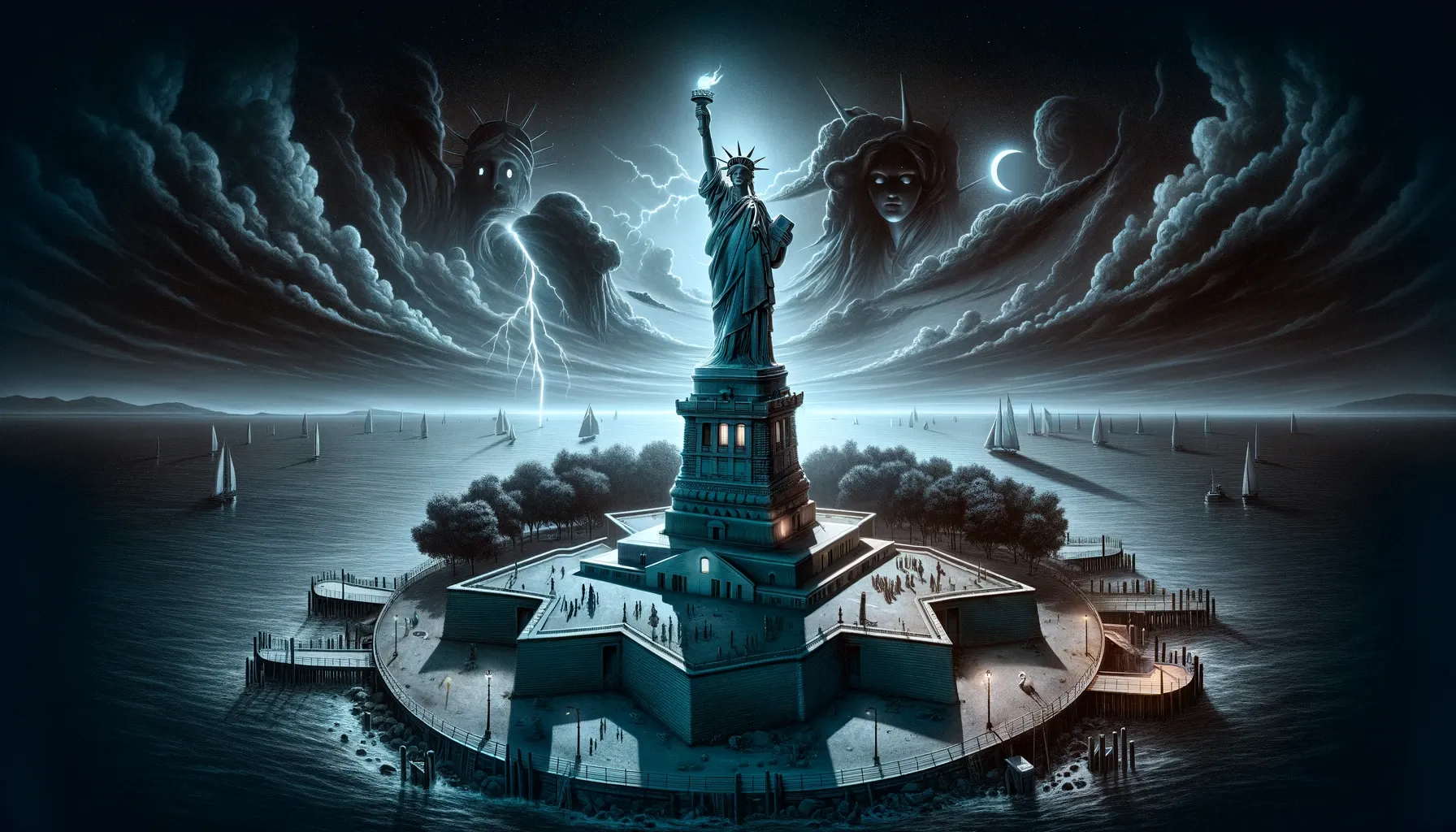Table of Contents
Understanding 50 Creepy Facts About the Statue of Liberty. Learn about her secret rooms, lightning strikes, symbolism, famous supporters, restoration efforts, and more bizarre history.
The Statue of Liberty is one of the most iconic symbols of America. Lady Liberty has welcomed immigrants arriving in New York City for over 130 years. While the statue represents freedom and democracy, its history is filled with some strange and creepy facts. Here are 50 creepy facts about the Statue of Liberty:

The Statue’s Face Was Modeled After the Sculptor’s Mother
The face of Lady Liberty closely resembles that of sculptor Frédéric Auguste Bartholdi’s mother. He used his mother Charlotte as a model for the statue’s face.
The Seven Spikes on Her Crown Represent Oceans and Continents
The seven spikes on the Statue of Liberty’s crown represent the seven oceans and continents of the world. This symbolizes liberty’s universal concept.
Her Tablet Bears a Date in Roman Numerals
In Lady Liberty’s left arm, she holds a tablet that is inscribed with “July 4, 1776” written in Roman numerals: JULY IV MDCCLXXVI. The date reflects America’s Declaration of Independence.
She Has Worn Eight Different Outfits
Lady Liberty has changed her outfits over the years. She has worn anywhere from a Roman stola to her current neoclassical robe.
Her Nose is 4.5 Feet Long
The Statue of Liberty has a pretty big schnoz! Her nose is 4.5 feet long, about the size of an average adult body.
She Has Three Sets of Stars
The robe and diadem (crown) feature 22 and seven stars, respectively. These represent the 22 states in the Union at the time and the seven seas and continents of the Earth.
Her Arm Was Displayed at the 1876 Centennial Exhibition
Before being installed in New York City, Lady Liberty’s arm was first showcased at the 1876 Centennial Exhibition in Philadelphia.
She Has a Secret Observation Deck in Her Crown
Inside the Statue of Liberty’s crown is a private observation deck. The National Park Service installed it in the 1980s, but it’s been closed to visitors since 2001 after the 9/11 attacks.
Installation Was Delayed for a Decade
From being gifted to the U.S. in 1876 to the statue’s dedication in 1886, Lady Liberty’s installation was delayed for about ten years. The pedestal had to be financed and built first.
Her Full Official Name Has A Very Long Title
The Statue of Liberty’s full official name is Liberty Enlightening the World. That’s quite a mouthful!
She Was Once a Lighthouse for 16 Years
For 16 years (1886-1902), the Statue of Liberty served as a lighthouse to safely guide ships sailing at night. Her torch was visible up to 24 miles away.
She Is Made of Copper But Turned Green With Age
Although Lady Liberty is made of copper, oxidation over 130 years has turned her a greenish-blue color. This process is called patination.
Over 600,000 Rivets Hold the Statue Together
Lady Liberty consists of hammered copper sheets assembled with over 600,000 rivets. The rivets allow the metal skin to move independently yet stay together.
She Withstood the Blizzard of 1888
In March 1888, the Great Blizzard of ’88 hit New York City. Lady Liberty amazingly withstood the heavy snow and winds reaching up to 85 mph.
She Has Had Many Close Calls With Destruction
The Statue of Liberty has risked destruction multiple times. She has been struck by lightning, survived nearby explosions, and even had an attempted bombing.
Her Torch Has Been Replaced Multiple Times
Lady Liberty’s iconic golden torch has been refurbished and replaced over the years. A glass torch also temporarily replaced the copper one during WWI due to copper shortages.
Over 3 Million People Visit Her Each Year
The Statue of Liberty is one of America’s most famous attractions. She welcomes over 3 million foreign and domestic visitors to Liberty Island every year.
She Has Had Two Suicides and Other Deaths
There have been at least two suicides and a couple of accidental deaths associated with the Statue of Liberty over the years. Most notably, a man jumped off the statue’s arm in 1929.
The Statue Was Once Used to Spy on Immigrants
During WWI, the Statue of Liberty looked over a U.S. Army detention center on Ellis Island. Army Intel used the statue’s torch to spy on immigrant activity and monitor ships traveling through New York Harbor.
Her Original Torch is Kept in the Lobby Museum
Lady Liberty’s original torch from 1886 is now housed in the Statue of Liberty’s lobby museum. It was replaced in 1984 due to weather damage. Visitors can see it on Liberty Island.
She Has Had Some Famous Supporters
Joseph Pulitzer, Oscar Wilde, Emma Lazarus, and Theodore Roosevelt were some of Lady Liberty’s early supporters who helped fund and build her pedestal. Pulitzer ran a newspaper campaign that raised over $100,000.
She Was Struck by Lightning in 1901
In September 1901, lightning struck and damaged Lady Liberty’s upraised arm. She was wearing a lightning rod cap to help divert strikes, but it wasn’t completely effective.
The Statue Has Its Postal Code
Liberty Island has its own designated postal code: 10017. Mail can be sent directly to the Statue of Liberty at this special postal code.
The Statue Almost Landed in Boston or Philadelphia
The Statue of Liberty could have been erected in Boston or Philadelphia rather than New York City. Both cities vied for the statue when deciding its final location in America.
She Had a Long Journey From France to America
The Statue took a long ten-week sea voyage from France to New York City. She was broken down into 350 pieces and packed in over 200 crates to transport across the Atlantic.
Actress Audrey Meadows Funded Repairs in the 80s
In 1982, actress Audrey Meadows funded half the repairs needed for the Statue of Liberty. The National Park Service matched her $250,000 donation. Meadows is most famous for playing Alice Kramden in The Honeymooners.
The Black Tom Explosion Damaged Her Torch
In 1916, the Black Tom explosion went off in Jersey City. Debris and shrapnel from the blast visibly damaged the Statue of Liberty’s torch and arm. That same night, another explosion on the Jersey shores added more damage.
She Was Closed for Security Reasons During WWII
The Statue of Liberty shut down completely during World War II for safety concerns. The public could not visit her between 1941 and 1945 when she was deemed unsafe given events overseas.
Read more here: Travel Hacks and Travelers Internet

Her 350 Individual Parts Were Delivered in 214 Crates
To transport her safely across the Atlantic Ocean from France to America, the Statue of Liberty was systematically dismantled into 350 pieces. Each part was carefully packed into 214 crates for the long voyage by sea.
The Statue Has Undergone Two Complete Restorations
In the 1980s and 1990s, the Statue of Liberty underwent two big restoration projects. This included replacing the original iron infrastructure with stainless steel and adding an elevator.
Visitors Could Once Climb to Her Torch
For safety reasons, the public has been banned from accessing the Statue of Liberty’s torch since 1916. Before that, visitors could climb up a spiraling staircase inside Lady Liberty to the top.
She Was Almost Gold Rather Than Copper
The Statue of Liberty could have been gold instead of its current copper color. Congress vetoed the use of gold since it was too expensive and impractical for such a colossal statue.
France Gifted Her to America in 1876 for Their Centennial
The people of France gifted the Statue of Liberty to America in 1876 to commemorate America’s 100th anniversary of declaring independence. She arrived ten years later in 1886.
There Are Various Miniature Versions of Her Around the World
Besides the OG Statue of Liberty in New York City, there are several smaller replicas of Lady Liberty around the world. You can find mini Statues of Liberty in France, Norway, Las Vegas, Japan, and more.
She Had Her Own Broadway Musical in the 1980s
In 1986, the same year as Lady Liberty’s centennial celebration, an original Broadway musical called “Liberty” premiered. The show told the story behind Lady Liberty and Ellis Island.
Her Official Flag Has a Symbol on It
The Secretary of the Interior has designated an official Statue of Liberty flag. The flag features the statue logo symbol signifying “Liberty Enlightening the World.”
Over 200,000 People Contributed to Fund Her Pedestal
Joseph Pulitzer helped crowdsource funding for the Statue of Liberty’s pedestal by publishing an appeal in his newspaper The World. Over 120,000 people contributed small donations totaling over $100,000 to help build the pedestal to hold Lady Liberty.
She Was Built with the Help of the Eiffel Tower Designer
Gustave Eiffel, the architect behind the Eiffel Tower in Paris, helped design the steel framework that allows the Statue of Liberty’s copper skin to move independently yet stay intact.
The Statue of Liberty Was Struck by Lightning in 1901
In September 1901, lightning struck and damaged Lady Liberty’s upraised right arm. She was wearing a lightning rod cap to help divert strikes, but it wasn’t completely effective.
The Seven Rays on Her Crown Represent Sun Rays
In addition to the seven spikes representing continents and oceans, the seven rays depicted on the Statue of Liberty’s crown symbolize sun rays. This represents “Liberty Enlightening the World” per her official name.
She Was Inspired by Ancient Roman and Greek Statues
The Statue of Liberty was designed after ancient Roman and Greek statues depicting their gods or royalty. She has a similar draped robe, illuminating torch, and size grandeur as statues of antiquity.
Visitors Used to Be Able to Picnic at Her Feet
Imagine having a picnic at the feet of Lady Liberty! Before visitor access was limited, tourists could enjoy lunches and dinners right on the grassy lawn surrounding the statue’s pedestal on Liberty Island.
She Has Had Some Famous Supporters
Joseph Pulitzer, Oscar Wilde, Emma Lazarus, and Theodore Roosevelt were some of Lady Liberty’s early supporters who helped fund and build her pedestal. Pulitzer ran a newspaper campaign that raised over $100,000.
Her Official Color is Lexan Patina Green
If you ever need to recreate the Statue of Liberty’s greenish-blue color, the official name is “Lexan patina green.” This references the aged patina that has developed on her oxidized copper surface.
She withstood the Effects of Hurricane Sandy
In October 2012, Hurricane Sandy hit New York City. While the Statue sustained some minor damage, she impressively withstood sustained winds up to 90mph and stayed standing tall after the storm.
She was Turned into a Church Bell at the End of WWI
During WWI, the Statue of Liberty’s precious metal was at risk of being melted down and used for war efforts. To prevent full demolition, Congress voted to turn parts of her copper skin into church bells and other small items.
Parts of the Statue are from the Copper Mines of Norway
The iron framework of the Statue of Liberty came from France, but the copper used for her skin came from copper mines in Norway. This European copper was shipped over to construct Lady Liberty.
She Was Coated in Germany-Donated Gold Leaf
To give the Statue of Liberty her current color, she was coated in gold leaf applied by German immigrants. Andrew Carnegie also helped with costs associated with gilding her torch and diadem.
Tourists Could Once Climb Her Arm to Reach the Torch
From 1886 to 1916, adventurous tourists could climb a narrow iron ladder up through Lady Liberty’s extended right arm to reach the torch balcony surrounding her glowing flame. The climb was nearly 40 feet but rewarded visitors with spectacular harbor views.

She represents an Abolitionist Symbol Against Slavery
Lady Liberty represents freedom from oppression and tyranny. When the statue was proposed in 1865, she was an abolitionist symbol representing the end of all slavery in America following the Civil War and ratification of the 13th Amendment.
The Statue of Liberty’s history is filled with fun facts and intriguing details. Despite some creepy stories and close calls, Lady Liberty has persevered and remained a globally recognized symbol of freedom. Her steadfast presence continues to welcome immigrants after over 130 years in New York Harbor.




